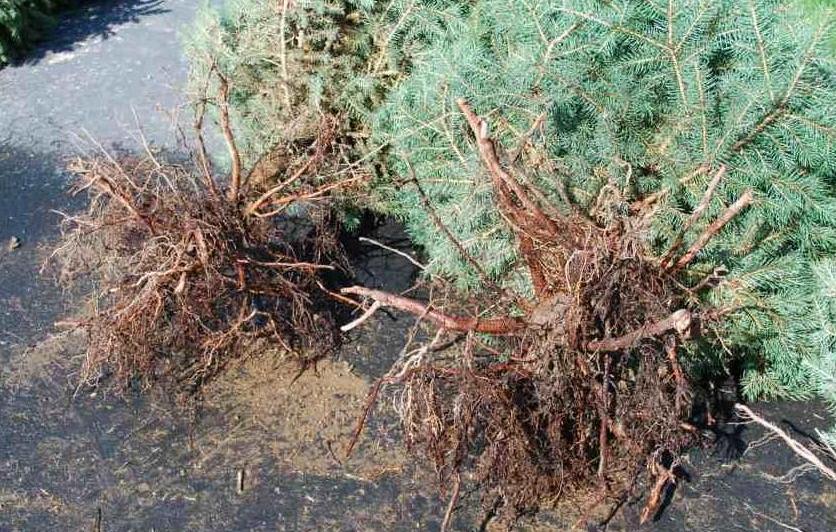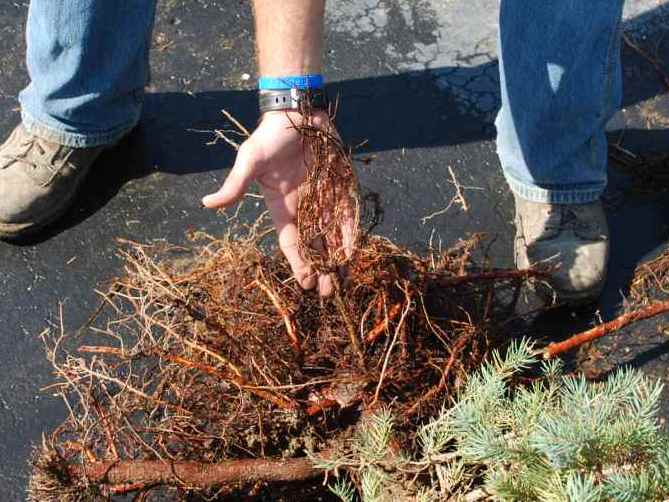As someone who has had a foot in Horticulture and a foot in Forestry throughout most of my career, people often ask me to compare the two disciplines. One of the truisms that applies in both cases is, “When all else fails, blame the nursery.” I’ve seen this following seedling die-offs in industrial forest plantations and I’ve seen it many, many times after street tree or landscape planting failures. In fact, if you believe some people, tree nurseries are responsible for every plague and pestilence to ever afflict mankind. Are some tree failures related to things that happened in the nursery? Of course. But there are lots of things that can go wrong between a nursery and a tree’s final destination; and even more things that can go wrong after it’s planted.
I know a lot of people don’t believe this, but nursery growers want their trees to survive and grow well after they leave their care. Growing trees is like making cars and any other business. You need satisfied customers if you expect to have repeat business. The best growers are always looking at their production practices for ways to improve their product. Last week I visited Korson’s tree farm in central Michigan. Korson’s grows Christmas trees and B & B landscape conifers. Rex Korson, the owner, has been concerned over the impact of root loss during transplanting of landscape trees. So much so, in fact, that he is conducting his own trial on root pruning.
For those that are not familiar, root pruning of B & B trees is usually done a couple years before harvest by using a tree spade to severe tree roots. The spade used for pruning is slightly smaller than the one used for harvest, so that new roots stimulated by pruning are harvested with the root ball. Does it work? I did a root pruning trial a few years back to see if it could improve survival of fall-planted oaks and had mixed results. For Rex’s trees, however, the initial results were pretty impressive. In the first photo below are root systems of Norway spruce trees dug with a 30” tree spade. The second photo shows the root systems of trees dug with the 30” spade that had been root-pruned last October with a 24” tree spade. The response in one-year’s time was dramatic. At this point there no out-planting data but, other factors being equal, increasing the amount of roots harvested with the tree should increase transplant success.
I should hasten to point out that Rex is not alone. I work with many other growers in the state that are constantly tinkering with this or that in their production systems; sometimes on their own, sometimes with university specialists or extension educators. I’m not so Pollyanna to think that everything is always rosy in the nursery world but most growers, especially the better ones, are aware of the issues out there and are working to build a better tree.

Spruce dug with 30″ spade without root pruning

Norway spruce root-pruned in Oct 2011 with a 24″ spade and dug Oct 2012 with a 30″ spade.

Close up of new fine roots

Tree spade mounted on excavator for root pruning. With this system an operator can root prune 8 trees in 5 minutes.
</d
Wow! I don’t think I’ve ever seen a side by side comparison of root pruning that was
quite so impressive. Any other species tested?
Bert and Jeff, did you see Ed Gilman’s article this month on root pruning and resulting root growth in AUF? He also looked at tree stability as a result of root pruning.
Oh yes — in fact, I just cited it in a paper I’m putting together. Interesting stuff, especially when combined with some of his other work.
The key sentence in the entire post is . . . “At this point there no out-planting data but, other factors being equal, increasing the amount of roots harvested with the tree should increase transplant success.” Unfortunately, it will take many years of field observations under a wide range of conditions to know of these efforts make a real difference. Two additional studies I’d like to see are strategies for transplanting large (e.g., 6′-8′ evergreen specimens in bare root form), and the use of Missouri Gravel Beds to hold large evergreens prior to summer planting. To become increasingly sustainable, the nursery/landscape industry has to move away from digging large holes to hold soil containing no roots (the bottom half of many/most B&B rootballs removed from growing fields, then trucked hundreds to thousands of miles. The industry is consuming a lot of diesel fuel and labor to move “dirt” from a hole in a production field, to a second hole in a backyard!
I enjoyed the side by side photographs. I think such illustrations are great teaching tools, not only for present and future techniques, but also in educating to the average person just how nature really works. Many of the above ground and below ground things that go on in a healthy forested environment are done by wildlife. The loss of wildlife in an ecosystem or at best very low numbers hurts the ecology of an area. Sometimes critters like gophers are demonized, but truly the components like snakes which have been removed from many areas have created an out of balance situation. But everything has it’s place. Learning how nature operates before it’s gone is a great way to replicate and improve techniques in the landscape biz or habitat rebuilding project. Thanks again for this.
Where can I find Ed Gilman’s article? Thanks.
Kenny, here’s the citation: Gilman, E.F. and C. Wiese. 2012. Root pruning at planting and planting depth in the nursery impact root system morphology and anchorage. Arboriculture and Urban Forestry 38(5): 229-236. (It’s not available online unless you have a subscription to the journal. Best bet is to contact your local extension office and ask them to retrieve it for you. Most land grant universities will carry this subscription.)
Jeff:
He is also had some blue spruce with similar, although not quite as spectacular results. I agree, for a one year resposne it’s pretty impressive.
Terry, as you note, it is an important caveat. I didn’t want to make the post too long-winded but this is not the final harvest size for these trees. Rex will grow them on for another two years but intends to keep tracking the root development between pruned and un-pruned over time. hopefully we can track some post-plant as well. The main point I was trying to make here is that nurseries get a lot of bad press – sometimes deserved – but many growers are dedicated to improving tree quality. In terms of bare-root trees, we can do pretty well with deciduous trees IF the people transporting and handling the trees know what they’re doing. Nina Bassuk at Cornell has developed an extensive body of information http://www.hort.cornell.edu/uhi/outreach/pdfs/bareroot.pdf Six to 8 ft bare-root conifers, on the other hand, would be tough. Maybe someone can prove me wrong, but the logistics and potential for desiccation just seem too tough to overcome. I think container production is more likely solution to the ‘trucking dirt’ problem.
Bert, et.al.:
I don’t know what the result of the project described at the following link (i.e., transplanting a large weeping Norway spruce bare root via an air spade), but there’s been a fair amount of work done over the years in transplanting very large deciduous trees in bare root form, http://www.fotitree.com/landscapeservices/bare_root_transplant.htm.
Oops, the weeping Norway spruce air spade transplant link I meant to include is: http://takingplaceinthetrees.net/2010/05/10/weeping-norway-spruce-bare-root-transplant/. It would’ve been interesting to see what might have happened if Rex had replanted the root-pruned trees immediately after taking the pics? After all, the roots had never had a chance to dry out?